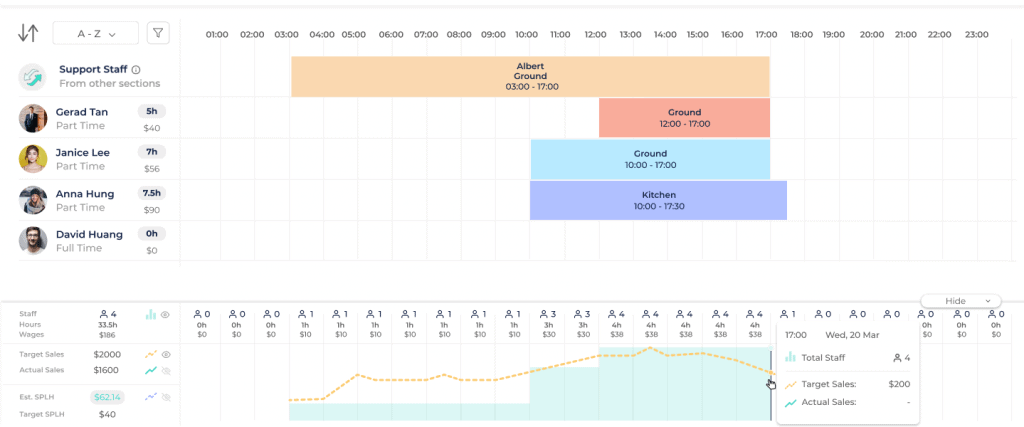Ever questioned how a simple act of scheduling could greatly affect your business performance? Yup, we’re talking lower labour costs, higher sales revenue per day.. I.e. impacting the bottomline. Believe it or not, your choice of who you schedule, when you schedule and how you schedule is that powerful — read on
Before we dive in, why exactly should we optimise scheduling, and what kind of optimisation are we looking at? There are several optimisations businesses and teams care about, including but not limited to: keeping under costs, hitting sales targets and scheduling the best staff.
1. Schedule within labour budget
As a manager (or owner) in charge of the schedules, you’re doing more than just slotting people into shifts, though you might not always feel that way. Labour costs account anywhere from 15 to 40% of business costs and you play a key role in keeping that down. Simple things you can do:
- Ensure you calculate (or better, automate) the weekly schedule costs. Excel can help, but we help you do it automatically so you don’t have to go crazy over the formulas 🙂
- Reducing OT as much as possible, by fully utilising all available manpower on hand
2. Schedule better performing staff
Not all staff are created equal! Some do the bare minimum, some try to avoid the tough work and others go above and beyond. Understandably – hourly work can be mundane, is very hard labour and yet defines a large part of the customer experience! (Grumpy staff leave us all a bad taste, yikes…)
A little too simplistic, but you get the idea.
It’s in the company’s interest to schedule these high performing staff more often – those who clock low absenteeism and are rarely late. That said, also make sure not to overwhelm them though, like accidentally scheduling them on too many consecutive days shifts.
Psst. helps if you have a scheduling system that can auto-schedule your staff based on rules such as high performance metrics (lateness, absenteeism), and customise the maximum number of consecutive shift-days! 🙂
3. Schedule with Visibility on Sales Targets
Moving from manual scheduling to digital scheduling for the hourly work industry is one thing. But having hourly sales to back it up? Now that’s a super power!
The basics of scheduling are simple and clear to all – schedule quickly, flexibly, accurately and without mistakes. But..

That’s not all.
Truly powerful scheduling helps businesses achieve their business goals.
Business goals are not to “make the least mistakes” and “be as fast as possible”, am I right?
It’s the bottom line!

Having a more precise visualisation of your target sales ensures that you schedule more accurately following store demand. For instance, by not over-scheduling when there is not that much sales expected. You don’t want 5 staff in your outlet in the early morning where you could already run smoothly with 3 as the expected sales are lower anyway!
That’s the latest power-up we launched for our scheduling, to help you be on your way to hitting your sales targets 🙂
Here’s a sneak peek of how it looks like when you combine it all:

4. ~Leave~ no room for mistakes
You’ve gone overseas (pretend it’s 2022, we like to be optimistic) and because it’s digital detox time, you’ve switched off your phone. The sakuras are blossoming… you’re enjoying… and your manager in Singapore’s impatiently tapping his fingers.
“WHERE IS HE!?”
Poor communication is the worst breakdown for companies operating in shift work! Being heavily reliant on each and every staff to ensure things run smoothly, the last thing you need is someone not turning up.
Unfortunately, that’s all too common when you’re working on manual scheduling across different platforms like WhatsApp and Excel. Scheduling someone on leave, double-scheduling someone to 2 locations or even reading their availabilities wrongly. (If you don’t suffer from these, congrats! You’re a master manual scheduler by now)
Ensure sufficient mechanisms are in place to flag out errors so that operations can roll as smoooothly as possible.
5. Automate the Automate-able!
– Asking for availabilities and receiving them
– Automatic calculations of the cost of your schedule (as mentioned in point #1)
– Notifying staff of their assigned shifts once schedules are out
– Reminding staff of their upcoming shifts
Nuff’ said! These don’t belong in your job scope. (It’s in ours, actually ;)) When you automate the annoying, manual work that you have to deal with every single week, you really make space to work on more fun, impactful stuff!
Adios, bad schedules!
All that said, we’ve left some actionable steps you can take on your own to optimise your scheduling (regardless whether it’s:
– putting in a system to identify better performing staff,
– ensuring visibility over your schedule’s “cost”, or
– scheduling with business revenue in mind.
If you however, want a solution that can do that all for you, you’re looking at one right now 🙂 Check out how we’ve helped companies like Foreword Coffee save up to 66% of time on scheduling and improved Dimbulah Coffee’s staff punctuality by 30-40%.





